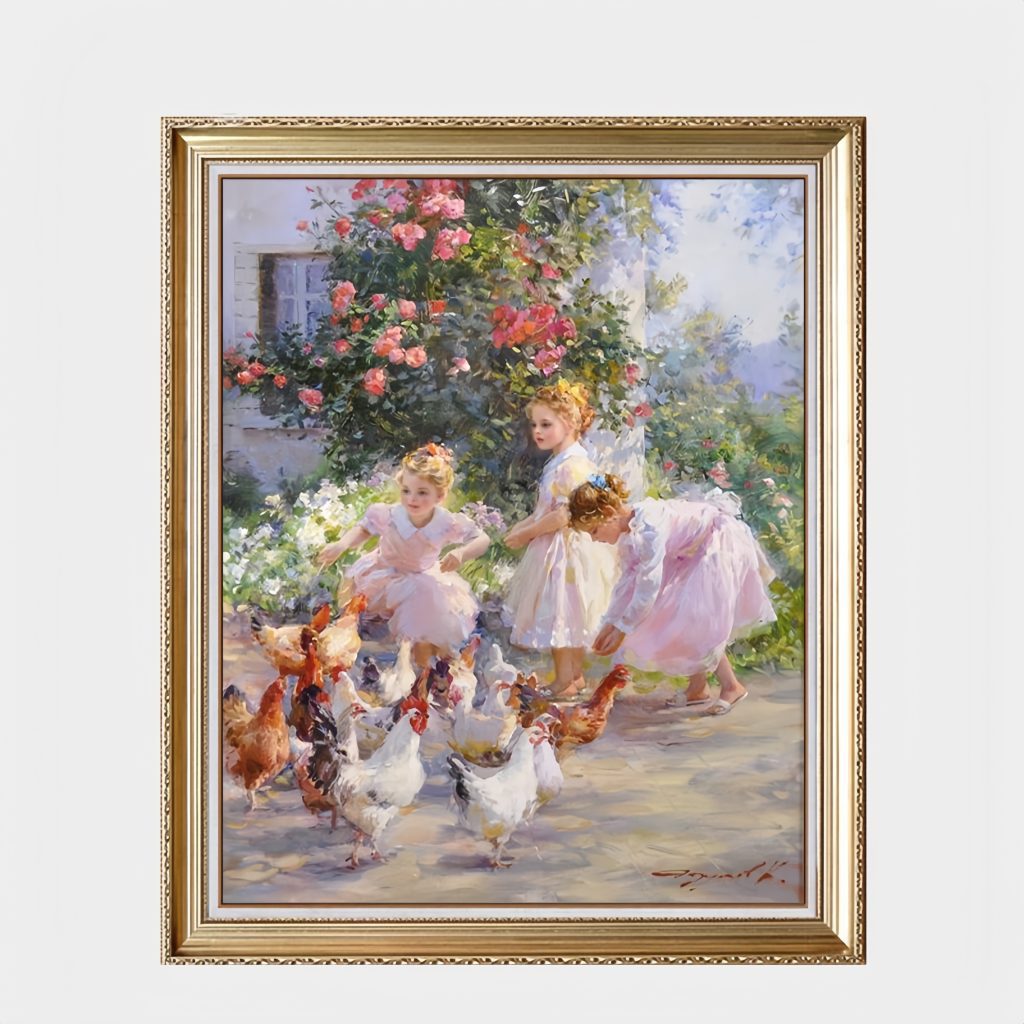Capturing Innocence and Energy: Distinctive Features of Hand-Painted Oil Portraits of Children
Painting children in oils requires a unique approach to convey their youthful vitality, curiosity, and unfiltered emotions. Unlike adult portraits, which often emphasize structure and realism, child-focused artworks thrive on softness, exaggerated features, and dynamic compositions that reflect their ever-changing world. Below are the defining elements that make these paintings stand out.
Exaggerated Facial Proportions for Expressiveness
- Oversized Eyes and Foreheads: Children’s faces are naturally dominated by large, round eyes that convey wonder and openness. Artists often enlarge these features further, placing them slightly lower on the face to emphasize innocence. A high forehead, rendered with smooth, pale tones, adds to the impression of youth, while subtle shading around the temples suggests the softness of baby fat.
- Small Noses and Mouths: To balance the eyes, noses and mouths are painted smaller and more delicate. A tiny, upturned nose with a soft pink blush and a petite, rosy mouth (often slightly open to imply speech or laughter) creates a charming, approachable look. For toddlers, adding a hint of drool or a pacifier can enhance realism without sacrificing cuteness.
- Chubby Cheeks and Dimples: Full cheeks are a hallmark of childhood, painted with warm peach or pink tones and gentle highlights to suggest plumpness. Dimples, whether natural or implied with a curve of the brush, add character. Use a dry brush to blend these areas seamlessly into the jawline, avoiding harsh edges that might age the subject.
Dynamic Poses and Playful Composition
- Movement Through Gesture: Children rarely sit still, so their portraits should feel alive with energy. Capture mid-action poses—a leap, a twist, or a tilt of the head—using fluid brushstrokes to imply motion. For example, paint a child’s dress or hair flowing upward to suggest they’ve just spun around, or use loose, wavy lines for arms and legs to convey restlessness.
- Interactive Backgrounds: Unlike static adult portraits, children’s paintings often incorporate elements of their environment to tell a story. A swing set, a pile of toys, or a window showing a garden invites viewers into the child’s world. Use vibrant, patchwork colors for backgrounds (e.g., a rainbow-striped wall or a grassy field dotted with daisies) to mirror a child’s imagination.
- Unconventional Angles: Experiment with perspective to add drama. Painting from a low angle, as if looking up at a towering child, emphasizes their growth and confidence. Conversely, a bird’s-eye view of a child playing on the floor creates intimacy, focusing on tiny hands grasping toys or scattered crayons.
Vibrant, Playful Color Palettes
- Soft Pastels for Innocence: Light pinks, baby blues, and mint greens dominate the face and clothing, evoking a sense of purity. These hues work best when layered with translucent glazes to avoid chalkiness. For example, a pale lavender shadow under the eyes can soften harsh light without darkening the scene.
- Bold Accents for Personality: While the overall tone remains gentle, strategic pops of bright color add personality. A red bow in the hair, yellow rain boots, or a polka-dot dress brings the painting to life. Use these accents sparingly—too much saturation can overwhelm the subject’s delicate features.
- Natural Skin Tones with Warmth: Children’s skin has a rosy, golden undertone that differs from adult complexions. Mix titanium white with a touch of yellow ochre and cadmium red for a base, then add ultramarine blue to the shadows for coolness. Avoid overly brown or gray tones, which can make the child look older.
Emphasis on Emotion and Storytelling
- Expressive Eyes: The eyes are the focal point, painted with intricate details to reflect the child’s mood. For joy, add sparkling highlights and slightly raised eyebrows; for shyness, downturned lids and a timid gaze. Even in abstraction, a child’s emotions should be unmistakable—wide eyes filled with tears or a crinkled nose laughing.
- Imperfect Details for Authenticity: Unlike the polished finish of adult portraits, children’s paintings embrace quirks. A lopsided hat, mismatched socks, or a smudge of chocolate on the cheek adds relatability. These “flaws” humanize the subject, reminding viewers of their own childhood memories.
- Symbolic Elements: Incorporate objects that hint at the child’s interests or stage of life. A teddy bear clutched tightly suggests comfort, while a half-finished drawing on the floor implies creativity. For older children, a skateboard or a book can signal independence, using color and placement to reinforce their personality.
Textural Techniques to Mimic Youthful Softness
- Blurred Edges for Roundness: Children’s features lack the sharp angles of adults, so soften transitions between light and shadow. Use a fan brush or your fingertip to gently blend the cheeks into the jawline, or drag a dry brush through wet paint to create a feathered effect around the hairline.
- Impasto for Tactile Elements: Build up paint thickly for textures that invite touch—the bristly hair of a stuffed animal, the rough fabric of a knitted sweater, or the glossy surface of a lollipop. This layering adds depth and makes the painting feel more interactive.
- Glazing for Translucency: Apply thin layers of oil paint over dry sections to create a luminous quality. For example, a glaze of pale yellow over the forehead can mimic the way sunlight catches a child’s smooth skin, while a blue glaze on shadows adds coolness without darkening the tone.
By focusing on these elements, artists can create hand-painted oil portraits of children that resonate with warmth, nostalgia, and joy. The interplay of exaggerated features, dynamic composition, and vibrant color ensures these works transcend mere likeness, becoming timeless celebrations of childhood’s fleeting magic.
